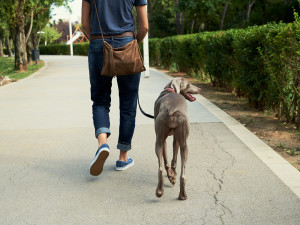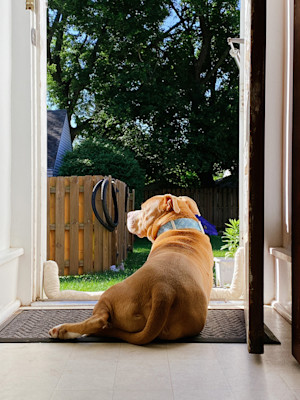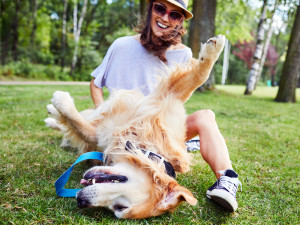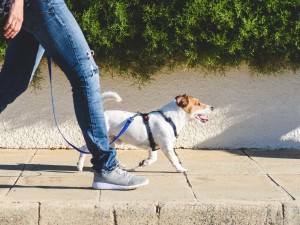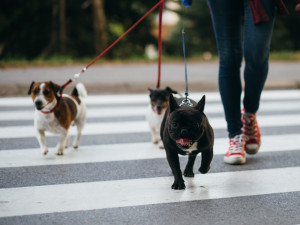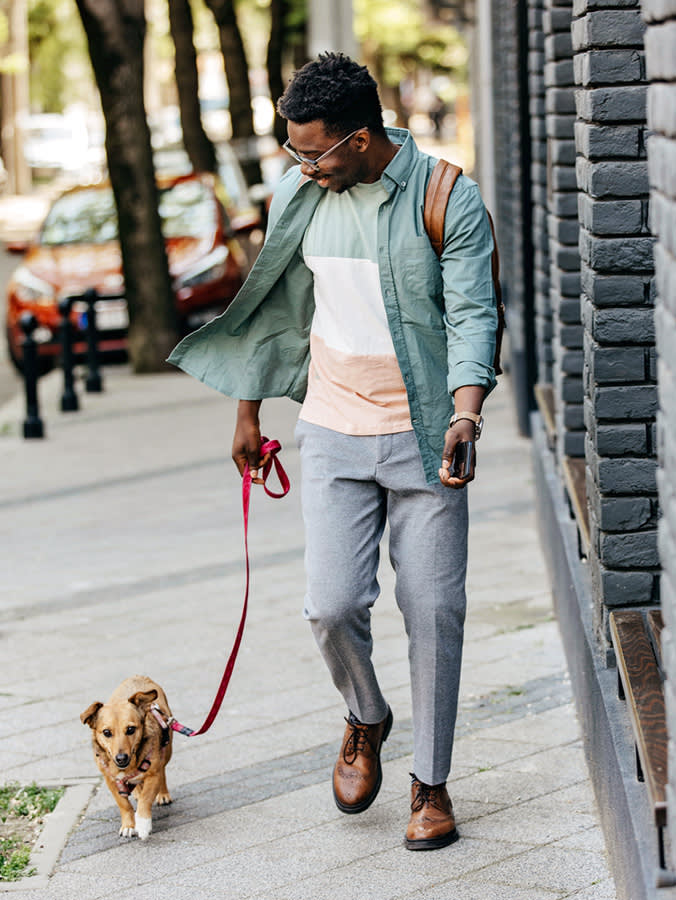
Share Article
Everyone knows the importance of regularly walking your dog, not only for a happier and healthier canine companion, but also (let’s be honest) a cleaner home; a daily dose of exercise is crucial for their physical health and psychological well-being, too. But what about the importance of where you walk your pup?
The debate on whether walking in the city or in natural settings affects our dogs has been rolling on for decades, with those who advocate exercising dogs in green spaces even giving it a label, calling it a ‘decompression walk’, to emphasise the potential rejuvenating effects of nature on our four-legged friends. But does science support their claim?
According to seasoned dog trainer and behaviourist Ria Edmensonopens in new tab, the suitability of your dog’s environment depends on various factors, including breed, socialisation and individual preferences. “It’s really difficult to say because it’s very dog-dependent,” adds Kate White, dog trainer and founder of SaintK9opens in new tab dog training. “The answer is probably, yes, where you walk your dog can have an effect on a dog, but it might show up in different ways for different pups.”
What are these effects and how do they present? We looked at the research and consulted the experts on the intricacies of urban versus rural dog-walking environments and their impact on our canine companions, as well as on us humans.
Does it matter where I walk my dog?
The idea that dogs might find solace in natural environments rather than amid city bustle has some understandable roots in evolutionary theories. Dogs descended from wild canines, such as wolves, and therefore it is deemed more ‘natural’ to let them live as wolves do now.
However, that logic doesn’t always sit right. Domestic dogs are genetically different to wild canines, as I’m sure your well-pampered pup can attest to, and have adapted as such. (Imagine the same reasoning applied to humans descending from apes, should we therefore be swinging around in the trees? No thanks).
That being said, this doesn’t necessarily mean that an urban environment is better for your pup, either. Other theories draw from similarities between human and canine psychology. With dogs exhibiting cognitive abilities akin to young children and even sharing certain mental health issues with humans, it’s tempting to extrapolate from human studies suggesting the benefits of nature walks for dogs. But applying human-centric findings directly to our four-legged friends isn’t always straightforward, either.
A study comparing the effects of walks in nature to neighbourhood strolls found no significant difference in cortisol levels, a hormone often indicative of stress, among dogs. Whilst using cortisol levels as a marker for stress is a new thesis, the study (Cupp, et al. 2023)opens in new tab sought to determine if urban walks elicited higher stress levels (raised cortisol levels) compared to jaunts in natural settings.
Contrary to popular belief, the study’s findings revealed no significant difference in cortisol levels between urban and nature walks. This suggests that our canine companions experience similar stress levels regardless of their walking environment, and city pet parents needn’t fret about ferrying their pups to greener pastures.
While some stress and behavioural differences were observed in the study, more research is needed to come to a more accurate conclusion. The dog’s individual characteristics played a more significant role, and the key instead lies in providing regular, fulfilling walks tailored to each dogs’ needs.
Kate emphasises the variability in dogs’ responses to different environments, noting that factors such as inadequate exposure to urban settings could potentially exacerbate nervous behaviours. “There’s no one-size-fits-all,” she says. “Due to a number of different things: it could be because of how the dog was socialised.” Whilst some dogs might find it overwhelming in the city, other dogs thrive.
Urban environments
Urban environments offer a plethora of stimuli for our dogs. From busy streets to bustling parks, there’s no shortage of sights, sounds and some very unique smells to pique their interest. “Research suggests 20 minutes of sniffing equates to around an hours’ worth of walking,” says Ria. “When they are sniffing something, they are learning and processing information we could never fathom.”
As Ria points out, “Urban areas naturally lend themselves to more sniffs with bins, more dogs, cats, foxes, etc, in a smaller spaced territory”. “Using their instincts like this will tire them out,” she adds. “So physical exercise is not just the most important thing – it is the mental and emotional exercise as well.”
On the other hand, there isn’t as much freedom – not as much green space, more rules like being on the lead – and some challenges unique to city living such as increased exposure to human waste (IYKYK), potential encounters with aggressive dogs and the omnipresent threat of traffic.
Rural environments
On the flip side, rural environments offer a playground for your pup. With vast expanses of greenery, cleaner air and fewer restrictions for off-lead runarounds, dogs can revel in their natural instincts. As Ria highlights, “Advantages of rural areas include more space, cleaner air, less noise and the freedom to express their natural instincts.”
Rural life isn’t without its drawbacks, however. From the risk of encounters with wildlife and farm animals to limited opportunities for socialisation, rural settings present unique challenges for pet parents.
Considerations for pet parents
Urban vs rural isn’t the only consideration when thinking about where to walk your dog, plus pet parents might not always have a choice. Other factors should pet parents consider include:
Individual needs: each dog is unique, with their own preferences and sensitivities. Pay attention to your dog’s body language and behaviour to gauge their comfort level in different environments.
Socialisation: early socialisation is critical for helping dogs adapt to various surroundings. Expose your puppy to different sights, sounds and experiences to build confidence and reduce anxiety. “It’s really vital before 16 weeks that the dog sees absolutely everything if you’re going to expect them to just be able to deal with the world,” says Kate.
Safety: consider the safety of both your dog and others when choosing walking routes. Urban areas may pose risks like busy roads and traffic, whilst in rural spaces you might encounter wildlife or uneven terrain.
Stimulation: dogs thrive on mental and physical stimulation, but that can differ between dogs. Choose walking environments that offer opportunities for exploration, sniffing and interaction with other dogs if your pup is inclined. Whereas, “Lack of socialisation in urban environments, and then expecting them to exist in an urban environment can exacerbate nerves,” says Kate.
Routine: establishing a consistent walking routine is essential for your dog’s well-being. Whether in the city or countryside, prioritise regular exercise to maintain their physical and mental health.
Breed-specific considerations
Ria sheds more light on breed-specific considerations. “If you live in a flat on the top floor with no lift, for example, do not go for a working type of any breed,” she says. “These dogs naturally need more space, so are more suited to a rural environment.” On the other hand, smaller breeds such as Frenchies, Pugs or Maltese may thrive in urban settings with their compact size and adaptability.
“Working breeds should be kept in a rural environment, or at least have access to a rural environment like a huge park or grounds to walk in,” she adds. “The amount of times I have trained working Cocker Spaniels for aggression because they are not worked enough, or pointers that have destroyed entire sofas because they do not have access to the space they need to ‘work’ and get it all out… I do not care to say.”
“Most breeds need around one to two hours of exercise, off-lead where possible,” adds Ria. It doesn’t have to be every day – some days, enrichment training can take the place of a walk, she says – but as much as you can, a minimum of four to five days a week. “It is equally important that you do not over-exercise dogs as well,” she says. “For puppies, the correct amount of exercise is recommended at five minutes per month of age, twice-a-day on hard surfaces such as pavement, with lots of training and enrichment is best.”
Environmental effects on humans
While much of the focus is on how walking environments impact dogs, it’s worth considering the effects on human companions as well. Research suggests that spending time in nature can benefit human mental healthopens in new tab, reducing stress and improving mood. On the other hand, urban environments can contribute to feelings of anxiety and fatigue due to factors such as noise and pollution.
A study on the ‘function’ of dog walksopens in new tab also suggests that the reason for the walk can also make a difference to the overall experience. Walks purposed through feelings of guilt (to provide the dog with exercise) were less pleasurable for the pet parent, whereas “recreational walks provided significant owner stress-relief and were longer, typically during pleasant weather and at weekends, in less urban environments and involved more members of the household”.
By choosing walking environments that align with both your dog’s needs and your own well-being, you can create enjoyable and enriching experiences for both of you. You may not always have the luxury of choice, but whether it’s a leisurely stroll through city streets or a romp in the countryside, the most important thing is to get out together, and to provide a calming and guiding influence for your pup.
References:

Orla Pentelow
Orla Pentelow is Kinship UK’s Senior Editor. She has previously written for British Vogue, Bustle, Yahoo and The Telegraph. When not at her desk liking dog videos she’s out and about with her rescue pup, Luna, who works primarily as chief distractor.
Related articles
![Dog walker walking with her pet on leash on the sidewalk]()
10 Tips You’ll Definitely Want to Follow When You Walk Your Dog
From the safest gear to training recommendations
![French bulldog lying on a bed with their head at a tilt]()
9 Common Dog Myths (That Are Actually False)
Sorry to break it to you, you might not know your pup as well as you think you do
![Woman walking her dog in a park]()
Dog Walking 101: How Often You Should Walk Your Dog
Your dog may need more exercise than you think, according to three pet experts
![Dog walker crossing a street with three dogs]()
How to Prepare Your Pup For Daycare and Dog Walkers
Set your pup up for success

